Discover the enchanting world of Shakuntala’s paintings by Raja Ravi Varma, as we unravel the poignant narrative and rich symbolism behind each canvas. Join us in a visual odyssey that celebrates one of Indian art’s most beloved figures, revealing the profound tales of love, myth, and destiny that have captivated hearts for centuries.
Table of Contents
Introduction
Raja Ravi Varma, a name synonymous with the renaissance of Indian art, remains an illustrious figure whose paintings are celebrated for their breathtaking realism and profound emotional depth. Born in 1848 in the princely state of Travancore, now part of Kerala, Varma’s artistic journey led him to become a pioneering figure in defining and popularizing a new visual language that intertwined Indian mythology with European techniques. Among his vast array of artworks, the depictions of Shakuntala, a beloved character from ancient Indian mythology, stand out for their unique blend of drama, naturalism, and cultural richness.
Shakuntala is a pivotal character in Indian literature and folklore, best known from the epic Mahabharata and the classical Sanskrit play “Abhijnana Shakuntalam” by Kalidasa. Her story is a poignant tale of love, destiny, and redemption, which has been retold across generations, each time resonating with the ethos of the era. In Raja Ravi Varma’s canvases, Shakuntala is portrayed not merely as a literary figure but as an emblem of Indian womanhood—graceful, dignified, and enveloped in emotional complexity.
Ravi Varma’s skillful brushwork brought Shakuntala to life with an elegance that captured the collective imagination of India. His paintings of Shakuntala decorating herself in anticipation of her beloved, or lost in the throes of despair when separated from him, are not just visual treats but are narratives woven in color. Through his art, Varma did not just immortalize Shakuntala; he etched her story into the very fabric of Indian cultural identity, making her a household figure and his art a bridge between the traditional and the modern.
Who Was Shakuntala?
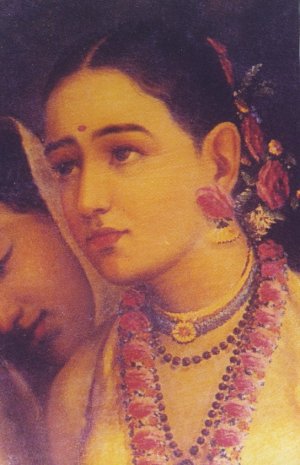
Shakuntala’s tale, as narrated in the Mahabharata and immortalized by Kalidasa in “Abhijnana Shakuntalam,” is a fascinating saga of love, loss, and recognition. According to the narrative, Shakuntala was the daughter of sage Vishwamitra and the nymph Menaka. Abandoned at birth, she was found and raised by another sage, Kanva, and grew up in the seclusion of a hermitage, blossoming into a woman of extraordinary beauty and virtue.
Her life takes a dramatic turn when she meets King Dushyanta during one of his hunting expeditions. Dushyanta, captivated by her charm, professes his love for Shakuntala, and they get married in a Gandharva marriage—a form of marriage by mutual consent, without rituals or witnesses. However, Dushyanta has to leave for his kingdom, promising to send for her. He gives Shakuntala a signet ring as a token of his promise.
The story escalates when Shakuntala, lost in daydreams of her husband, fails to attend to a visiting sage, who curses her by declaring that the person she is dreaming of will forget her. The curse, however, comes with a remedy—that Dushyanta will remember everything when he sees the signet ring he gave her. Unfortunately, Shakuntala accidentally loses the ring in a river. When she finally arrives at Dushyanta’s palace, he does not recognize her due to the curse.
Shakuntala’s significance in Indian mythology extends beyond her narrative. She represents the strength and resilience of love, the pain of separation, and the joy of reunion. Her story is also seen as a metaphor for the human soul’s journey—a quest for recognition and unity with the divine. In “Abhijnana Shakuntalam,” Kalidasa explores these themes with such sensitivity and depth that Shakuntala’s character transcends time and geography, resonating with audiences far and wide.
In the following sections, we will delve deeper into the specific paintings of Shakuntala by Raja Ravi Varma, exploring each artwork’s significance and the masterful depiction that Varma achieved through his pioneering techniques and expressive portrayal.
Birth of Shakuntala (1890)
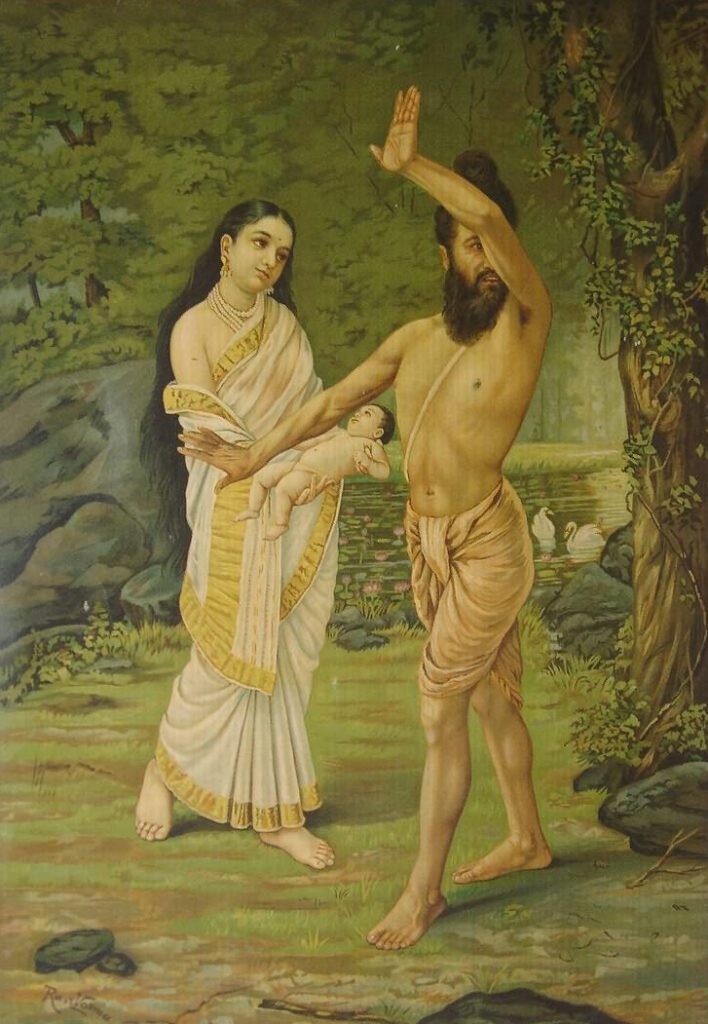
Painting by Raja Ravi Varma
- Description: In the 1890 painting “Birth of Shakuntala,” Raja Ravi Varma delves into the poignant origin story of the character. The canvas reveals a compelling scene where the sage Vishwamitra, with an expression of refusal and abstinence, turns away from Menaka, who presents their child, Shakuntala. The hermitage’s serene surroundings, rendered with Varma’s keen eye for natural beauty, form a striking contrast to the complex human emotions at the forefront. The painting beautifully captures the dichotomy between ascetic duties and the earthly ties of love and parenthood.
- Mythological Story/Context: The painting illustrates the crucial moment when Menaka, an apsara or celestial nymph, brings forth her daughter, Shakuntala, to sage Vishwamitra, who renounces the child due to his commitment to asceticism. The narrative speaks to the themes of abandonment and fate that will shape Shakuntala’s life, as she is eventually raised in a hermitage by Sage Kanva. Varma’s portrayal of Vishwamitra’s firm denial and Menaka’s somber acceptance adds depth to the characters, inviting viewers to reflect on the harsh decisions dictated by duty and the transcendence of love.
Shakuntala and Sakhis (Oleographic Print, 1930)
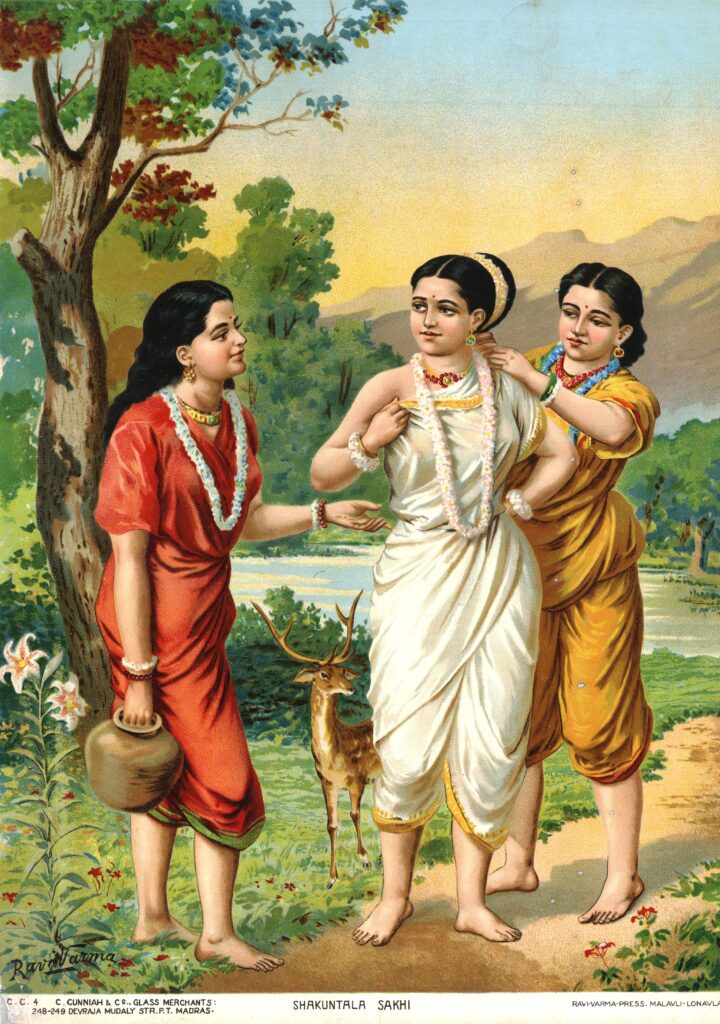
- Description: The oleographic print “Shakuntala and Sakhis,” created in 1930, showcases Raja Ravi Varma’s penchant for capturing the quintessence of Indian mythology with a vivid narrative. The artwork features Shakuntala, flanked by her two sakhis (friends), in an idyllic forest setting. Shakuntala stands at the center, her head slightly turned, a coy expression painted on her face, as one sakhi playfully adjusts her friend’s hair, while the other looks on. Their traditional attire is rich in color and detail, evoking the elegance of the era. A gentle deer stands beside them, symbolizing the harmony of the forest hermitage where Shakuntala was raised.
- Mythological Story/Context: This scene encapsulates a serene moment from the life of Shakuntala in the hermitage, surrounded by her friends and the tranquility of nature. The interplay of glances and gestures among the three women suggests a shared secret or a moment of teasing, likely concerning Shakuntala’s love for King Dushyanta. The beauty of this print lies in its ability to convey the innocence and camaraderie of Shakuntala’s youth, before the trials of her love story begin.
The oleograph is a testament to Shakuntala’s life before her encounter with King Dushyanta, highlighting the themes of friendship and nature that are so prevalent in her story. It’s a snapshot of life in the forest ashram, reflecting the simplicity and purity of Shakuntala’s world, which Ravi Varma brings to life with his masterful blend of realism and romanticism.
Shakuntala Looking Back to Glimpse Dushyanta (1898)
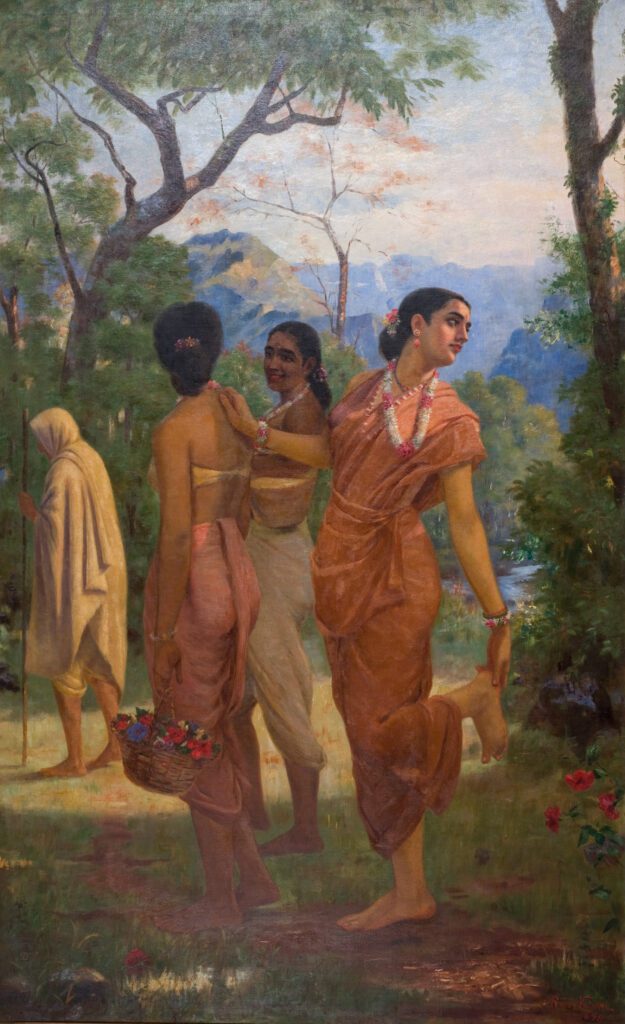
Shakuntala Painting by Raja Ravi Varma
- Description: In “Shakuntala Looking Back to Glimpse Dushyanta,” a 1898 painting by Raja Ravi Varma, we see Shakuntala in an evocative moment of allure and modesty. As she walks through a lush forest glade with her companions, her body language suggests a subtle, yet deliberate, pause under the guise of removing a thorn from her foot. The painting is rich with the hues of nature, complementing Shakuntala’s ochre attire that drapes around her with an effortless grace. Her backward glance, laden with veiled affection, captures the timeless dance of love and courtship.
- Mythological Story/Context: This canvas immortalizes a pivotal scene from the legendary love story of Shakuntala and King Dushyanta. The moment depicted is one of playful pretense—Shakuntala, ostensibly focused on a thorn in her foot, seizes the chance to steal a glance at her beloved, who is likely hidden from view but very much present in her heart and mind. It is a tender act of a lover’s yearning to see and be seen, to acknowledge the connection that is too profound for words.
This subtle act of looking back is symbolic, representing the inner conflict between Shakuntala’s demure self-restraint and the human desire to behold her loved one once more. Ravi Varma showcases his mastery in this painting by capturing both the shyness and the depth of feeling that Shakuntala embodies.
Shakuntala Patra Lekhan/Shakuntala Writing a Letter (Before 1906)
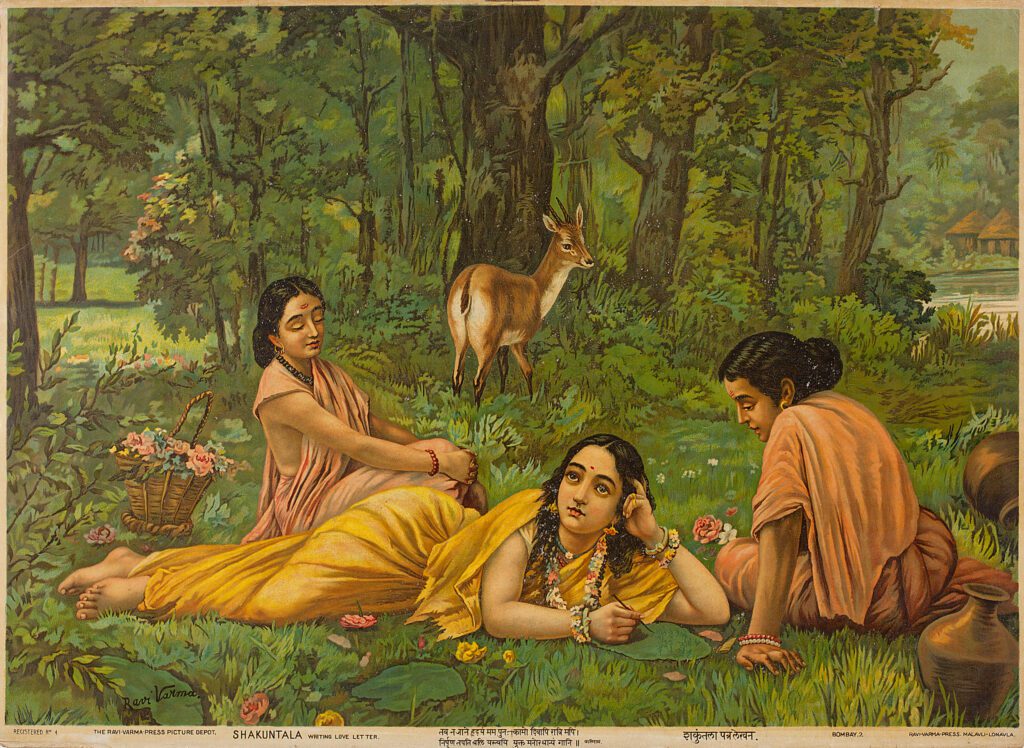
- Description: “Shakuntala Patra Lekhan” portrays a serene Shakuntala, engrossed in composing a letter to King Dushyanta. Created before 1906 by Raja Ravi Varma, this piece exudes a tranquil ambiance with Shakuntala depicted amidst the lush flora of the hermitage. She is dressed in a simple yet vibrant attire, with her traditional jewelry symbolizing her royal connection. Her friends, attentive and supportive, are by her side in this intimate moment. The attention to detail, from the folds of her saree to the delicate flowers in the basket, highlights Varma’s skill in depicting not just the scene, but the emotions enveloping it.
- Mythological Story/Context: In this visual narration, Shakuntala is seen drafting a letter to her husband, King Dushyanta, expressing her deep longing and love in his absence. This scene is significant as it captures a moment of vulnerability and sincere affection. Varma’s painting beautifully illustrates a slice of the epic where Shakuntala, despite the sage Durvasa’s curse that caused Dushyanta to forget her, holds onto the hope of rekindling their love. The act of writing the letter represents a mix of hope and despair, a desperate attempt to bridge the gap that destiny has placed between them.
Shakuntala Writing a Love Letter on a Lotus Leaf (Between 1880 and 1885)
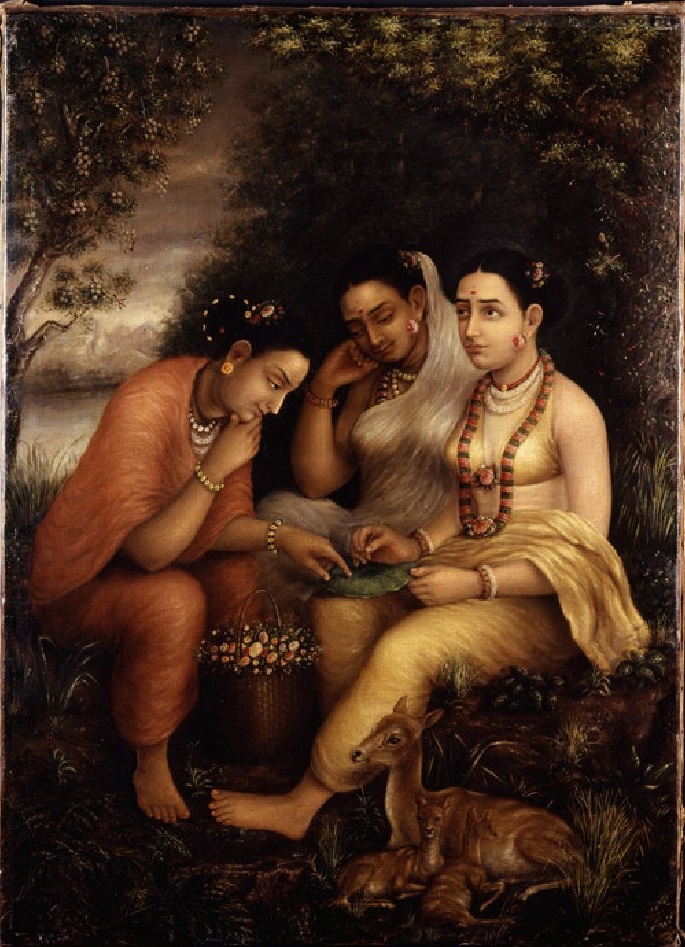
- Description: In “Shakuntala Writing a Love Letter on a Lotus Leaf,” painted between 1880 and 1885, Raja Ravi Varma immortalizes a moment of tender intimacy. Shakuntala is seated in a verdant forest glade, her body language relaxed yet concentrated, as she inscribes her feelings onto a lotus leaf – an innovative and poetic substitute for paper. The soft, dappled light filtering through the trees bathes the scene in a dreamlike quality. Attended by her loyal friends who are enveloped in their own silent dialogue, the scene is alive with the quiet pulse of nature and human connection. A gentle fawn lies nearby, symbolizing innocence and the undisturbed natural world.
- Mythological Story/Context: The painting draws from a touching moment in the love story of Shakuntala and King Dushyanta, capturing the raw emotion as she confides her love through a natural canvas. The use of a lotus leaf highlights Shakuntala’s resourcefulness and her deep connection to the natural world. It’s a poignant expression of her undying hope and undiminished love despite the physical absence of Dushyanta. Varma’s ability to depict the subtle interplay of nature and emotion speaks to his mastery in storytelling through art.
Menaka and Shakuntala (1891)
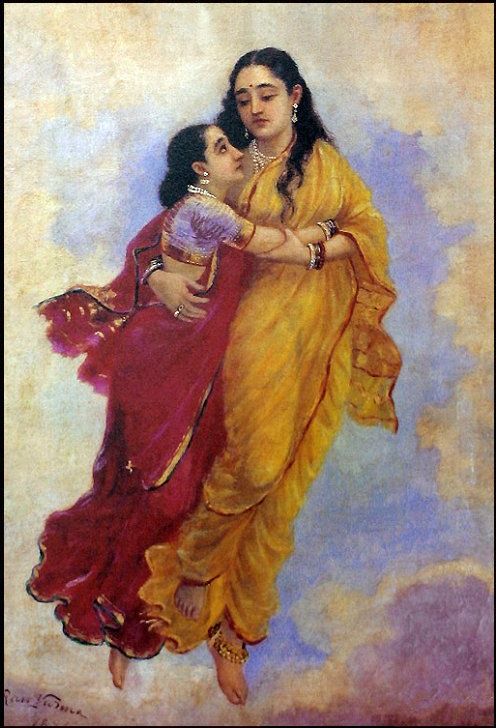
Shakuntala Painting by Raja Ravi Varma
- Description: The 1891 painting “Menaka and Shakuntala” by Raja Ravi Varma is an emotional portrayal capturing the moment of union between the celestial nymph Menaka and her daughter Shakuntala. The artwork conveys the gravity of maternal love and acceptance. Varma’s use of warm, golden hues enveloping the figures enhances the sense of a celestial bond, with Menaka’s attire radiating a nurturing glow. Shakuntala’s delicate, youthful form clings to her mother, seeking comfort. The ethereal background suggests a realm beyond the ordinary, highlighting the otherworldly origins of Menaka and the destined path of Shakuntala.
- Mythological Story/Context: This painting illustrates the tragic juncture in Shakuntala’s life where she is embraced by her mother Menaka at a time of vulnerability—after being forsaken by her husband, King Dushyanta. The backstory to this scene is steeped in tragedy and cosmic design; Menaka was sent to earth by the gods to disrupt Sage Vishwamitra’s meditation, resulting in Shakuntala’s birth. Later, as prophesied, Menaka leaves the infant Shakuntala in Sage Kanva’s care. This poignant reunion captures a fleeting moment of maternal solace before destiny unfolds, leading Shakuntala to her fated trials and ultimate reconciliation with her love, King Dushyanta.
Shakuntala lost in thoughts (1901)
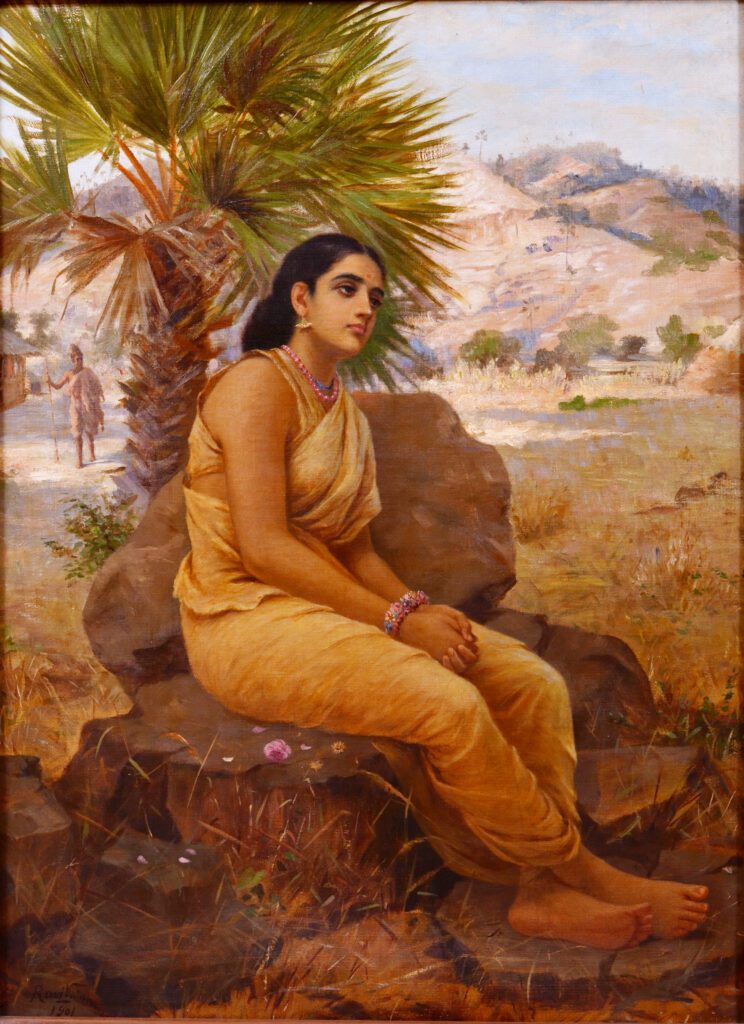
- Description: “Shakuntala Lost in Thoughts” by Raja Ravi Varma is a poignant oil on canvas that encapsulates the essence of longing. Created in 1901, the painting shows Shakuntala, draped in a mustard saree, sitting on a rock, her eyes filled with a distant yearning. Her posture is relaxed yet reflective, capturing a moment of deep thought. The natural surroundings, from the textured rocks to the serene foliage, frame her in harmony with nature, reflecting her origins and current state of contemplation.
- Mythological Story/Context: This piece is steeped in the narrative of “Abhijnana Shakuntalam” by Kalidasa, where Shakuntala pines for her husband, King Dushyanta, who has left for his kingdom and in whose memory she is lost. Varma’s painting is set in this period of anticipation and uncertainty, where Shakuntala wonders about her future, awaiting the king’s return. It is a moment that captures her emotional depth and the vulnerability of her situation—love and separation entwined in a single, silent frame.
Conclusion
The tapestry of Shakuntala’s narrative, as depicted through the masterstrokes of Raja Ravi Varma, transcends the mere retelling of an epic tale. It becomes a canvas where emotions are palpable, the cultural ethos is celebrated, and each color and shade tells a part of her poignant story. Varma’s paintings take us on a journey through Shakuntala’s life—from the innocence of her forest upbringing to the complexities of love and the aches of longing and abandonment.
Through the artist’s vision, we not only witness the evolution of Shakuntala as a character but also engage with the universal emotions that she represents: love’s first blush, the despair of loss, the solace of maternal embrace, and the silent strength of hope. Varma, with his exemplary skill, ensures that Shakuntala’s saga is not just a series of events but a living, breathing experience that still resonates with audiences today.
For those who have been captivated by the story of Shakuntala and the evocative imagery of Raja Ravi Varma, there is more to explore. We invite you to delve deeper into the romantic realms crafted by this legendary artist in our last article, “Top 10 Romantic Raja Ravi Varma Paintings You Must See.” Discover the myriad expressions of love and beauty that Varma so uniquely captured in his work. Visit Top 10 Romantic Raja Ravi Varma Paintings You Must See and let the romance continue to unfold before your eyes.
